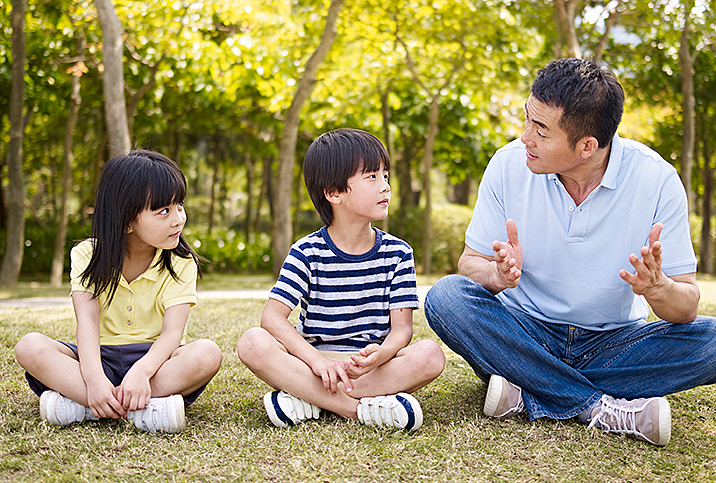Instilling Body Autonomy in Children

Shalon Nienow, M.D., division director of Child Abuse Pediatrics at Rady Children's Hospital San Diego, defines body autonomy as, "The right for a person to govern what happens to their body without external influence or coercion."
Simply put, body autonomy is the right to make decisions for our own bodies without outside interference. The body autonomy discussion is often reserved for the field of reproductive health, but it applies to everyone, including children.
It's easy to dismiss a child's right to autonomy: We instruct our children to finish their food, to give grandma a hug and to wear the clothes we choose for them. We do all of these things with their best interest at heart, but what if we're sending the wrong message entirely?
I'm a mother of three, and I've been guilty of disrespecting my kids' right to make decisions for themselves and their bodies. Here's what I learned in the process of switching gears to get them, and myself, on the right track.
Why is it important to teach and respect body autonomy early?
The lessons we learn in childhood are ones that often define and shape us, so it stands to reason that teaching a child that they are in control of their body from a young age is an effective way to ensure they carry the belief through adulthood.
By teaching kids to develop and enforce strong boundaries for their bodies, we're empowering them to be advocates for themselves and their bodies. Statistics show 1 in 9 girls and 1 in 53 boys will experience sexual abuse or assault at the hands of adults by the time they're 18 years old. Many times, this abuse comes from people they know and are familiar with.
While forcing a child to hug their grandparent may seem innocent enough, the reality is it's teaching a child their boundaries don't matter. By pressuring a child to engage in physical affection they're uncomfortable with—no matter the reason—we're sending a message that they need to be affectionate because it's "polite" or "just what you do." This discourages them from trusting their instincts and honoring any boundaries they've put in place for themselves.
Ways to encourage body autonomy in children
There are several ways adults can encourage body autonomy in every child—not just their own kids. Caregivers, teachers, aunts, uncles and grandparents alike can benefit from learning to teach kids that they are in charge of what happens with their bodies.
Kristen Pavlik McCallie is an abuse prevention advocate professional who's learned much in her more than 15 years of experience in victim services and five years of experience specifically advocating for children.
"The biggest takeaway is that kids can set their own boundaries around their bodies, regardless of age," McCallie said. "And regardless of age, they need to have 'safe adults' who children can trust to help them if something happens."
'A powerful tool in empowering kids to let adults know what their body boundaries are...'
One step McCallie suggests taking is for families to build a Family Code of Conduct. A Code of Conduct is familiar to most of us who have worked for larger companies, and the concept is similar when creating one for your family. It should outline your family's expectations in a way that reflects your values.
McCallie calls it, "A powerful tool in empowering kids to let adults know what their body boundaries are, what makes them feel uncomfortable and what to do when a situation that makes them uncomfortable arises."
Once your family has written their Code of Conduct, McCallie stresses the family's adults should then discuss those boundaries with other adults, including coaches, teachers and babysitters.
"They need to learn to listen to children's requests related to their body boundaries, and that proper names for body parts are the norm," McCallie said.
Other ways to teach and encourage body autonomy in children include:
- Teaching children the proper words for their bodies. When a euphemism like "cookie" is taught instead of "vagina," it can lead to a misinterpretation. For example, if a child reports to an adult that someone has touched their "cookie," the adult might brush it off thinking the child means a literal cookie instead of their genitals.
- Teaching children the difference between OK touches (consensual acts of affection that make them feel happy) and not-OK touches (anything else that makes them feel uncomfortable, confused or scared).
- Empowering them to say "no," even to adults, when it comes to physical affection.
- Letting children know that if something happens to their body that they are uncomfortable with, that it is not their fault, and they won't ever get in trouble for reporting it.
More than anything, McCallie emphasized adults' responsibility to report and stop child abuse.
"Being an active bystander is another way we, as adults, can protect children and reinforce boundaries," she said.
To do so, McCallie suggests reading this guide from Darkness to Light, a nonprofit with the goal of empowering adults to prevent child sexual abuse.
Subtle ways we discourage body autonomy
As a parent, I'm guilty of unconsciously discouraging my children's body autonomy. I realized this when my oldest daughter was about 5 years old. She had a close friend in her daycare class who was a hugger—and my daughter is not, and never has been, a hugger. One day, as we were leaving class, this little girl ran up to her with her arms out, wanting a hug. My daughter hid behind me, clearly uninterested in giving her friend a hug. In an almost knee-jerk reaction, I tried to pressure my daughter into hugging her friend—I didn't want to hurt the other little girl's feelings. It wasn't until later that I realized I was trying to spare her feelings at the expense of my own child's comfort.
There are many subtle ways we as adults discourage body autonomy in children, such as:
- Forcing affection in the form of hugs or kisses.
- Forcing children to eat food they dislike or finish everything on their plate: By doing this, we're sending the message that we don't trust them to know their own palate or hunger limits.
- Refusing to allow children to choose their own (weather-appropriate) clothing: This tells kids that we don't trust them to make decisions for themselves.
- Continuing a once-fun behavior, like tickling, after the child has clearly stated "no," "stop" or "don't."
The consequences of not respecting a child's body autonomy
Many of the "what not to do" things outlined above may seem innocuous—what's the harm in insisting my child gives her grandfather a hug, even when she doesn't want to? More than you think, according to McCallie.
"The biggest negative consequence of not empowering children to have strong boundaries and use proper anatomical terms is that they may be more likely to be victimized…both as children and as adults," McCallie said.
And while parents may feel awkward teaching their children to use anatomical terms like "penis," "vagina" or "breasts," encouraging children to learn and use proper body names can help give children the language to identify when someone has abused them.
In a 2018 article published by the John Jay College of Criminal Justice, professors Elizabeth Jeglic and Cynthia Calkins argue, "Parents should use correct anatomical language when referring to sexual organs starting in childhood. One study found that sex offenders were less likely to offend against a child if the child knew correct names for body parts; the offender felt that there was a greater risk that he or she would get caught as these children were more likely to talk to their parents."
McCallie suggests using the CDC's "Essentials for Childhood" as a starting guide to implementing these ideas and building upon them.


















